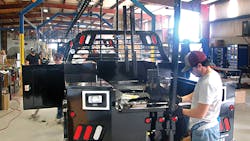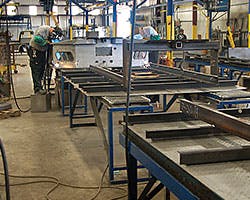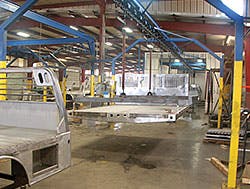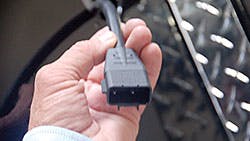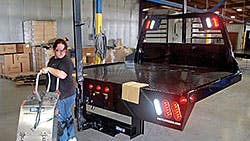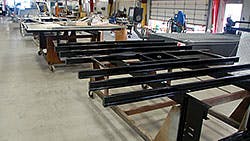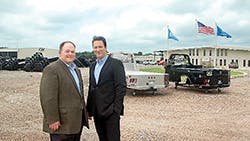CM Truck Beds goes all out to construct top-notch bodies
NEW PLANT. New product features. And new assistance for its growing network of truck equipment distributors. It’s been a busy 18 months at CM Truck Beds in Kingston, Oklahoma.
It’s not like the flatbed towing body manufacturer is new to the business. CM has been around for more than 20 years now. But the past two have been especially productive for the company. A new plant opened in 2014, making it possible for the company to produce 50,000 truck bodies annually.
But beyond that, CM has spent significant resources on its product line—adding new standard features and expanding the lineup to include new aluminum, steel, and hybrid versions. The company also has developed a variety of digital sales tools that distributors can use to market CM products.
Not bad for a product line that started as a complementary business for a gooseneck trailer manufacturer.
“That’s not us anymore,” says Joe Lewis, vice-president of sales and marketing. “We are very serious about truck beds. For example, we opened a 50,000-sq-ft truck bed plant in 2009. Even though that was at the bottom of the recession, we maxed out the capacity in 24 months. The plant that we opened last year essentially tripled our capacity.”
A key feature of the new facility is the separate line the plant has for manufacturing aluminum bodies. Along with that come four lines for steel product. A separate plant in Kingston specializes in custom body production.
“With the new plant, we can fill large fleet orders,” Lewis says. “We just finished an order for 500. And with the custom plant, we can produce something that’s completely different without affecting the efficiency of our higher volume lines.”
One of the biggest additions in the plant, however, is the new powder coating system and the indexed conveyor system.
The two-step process, management says, has been proven effective in tests involving magnesium chloride. A primer provides an effective bonding surface, particularly on edges. With the primer in place, the conveyor transports the bodies into the powder coat booth where powder is applied and then baked at 380° for 20 minutes.
Meanwhile, the chain-driven monorail conveyor has proven to be effective in driving efficiency. The conveyor, of course, sets the pace, one that continues through the powder coat line and on to the final finishing area. The company produces multiple types of truck bodies on the same conveyor line.
“Any bed is completely finished within an hour after coming out of the oven,” Lewis says. “We have automated both the assembly process and our finishing operation.”
Product upgrades
CM has invested in upgrading the features of its product line.
“We want to offer ‘feature rich’ products to our customers,” Lewis says.
Examples include making LEDs standard, a standard 14,500-pound rating for bumper hitches and 26,000 pounds for its gooseneck hitch, and a new modular sealed wiring harness that is “plug and play” for body installers—an option for all new CM bodies.
“This makes installation faster and eliminates errors,” Lewis says.
The plug and play harness will include a GM OEM male plug that attaches to GM model trucks dating back to 2007. CM also will offer adapters to fit Dodge and Ford chassis cabs.
Other recent improvements:
• Installation kits will come complete with bolts, nuts, washers, and mounting brackets to fit specific Ford, Dodge, and GM models.
• Installation kits are designed to match the specific truck, utilizing pre-drilled holes in the truck frame and enabling the body to be mounted without welding.
• T-handle latches provide compression against the integral toolboxes for a positive seal.
New products
At a time when Ford is introducing aluminum pickups and customers are increasingly valuing weight reduction and corrosion resistance, aluminum is becoming increasingly popular as a material for manufacturing truck bodies. That includes the types of bodies that CM manufactures.
One of the company’s recent introductions is a hybrid model—one that uses a steel subframe and aluminum sheet for the exterior. The steel enables the body to retain the towing capacity that steel bodies boast while providing much of the weight savings and corrosion resistance of aluminum.
The hybrid model joins a variety of aluminum bodies—flatbeds as well as ranch and tow bodies and a group of steel bodies for multiple applications. They include
• Bale spike bed. A steel body with integral underbody storage compartments, smooth sides, and bale spikes.
• Steel platform body. It includes square bulkhead.
• Steel skirted welder body.
• Gin pole truck.
Coming in the third quarter, CM plans to heavily promote its new steel dump body.
“We really do have a diverse product line, and we have designed them to fit all major OEM trucks,” Lewis says.
Tools for distributors
CM has introduced several tools for distributors to simplify selling and installing its products.
First is a three-dimensional animation system on its website that helps distributors and customers visualize how a particular body will look on a specific chassis.
“Our bodies are designed to fit Ford, GM, or Ram trucks,” Lewis says. “We have 3-D animation for all three brands. Each body has specific transition points at the front that fit the back of the cab for that particular truck. The 3-D animations help the customer see how the body matches the cab for that truck.”
CM provides other digital tools, including the ability to build websites for its distributors—including graphics, custom videography, and search engine optimization.
“We have more than 100 distributor websites live,” Lewis says. “A lot of what we offer can be done in-house, or we can put a photographer on an airplane and shoot at the distributor’s location. We have done television commercials for our distributors. We can manage distributor You Tube pages. We focus on pull-through promotions. We are more than just a supplier. We are an in-your-face marketing company.”
With a growing distributor network across the country, CM in conjunction with its parent company now has distribution centers in Cordele, Georgia, and Caldwell, Idaho. The regional truck body manufacturer is now nationwide. ♦
About the Author
Bruce Sauer
Editor
Bruce Sauer has been writing about the truck trailer, truck body and truck equipment industries since joining Trailer/Body Builders as an associate editor in 1974. During his career at Trailer/Body Builders, he has served as the magazine's managing editor and executive editor before being named editor of the magazine in 1999. He holds a Bachelor of Journalism degree from the University of Texas at Austin.
